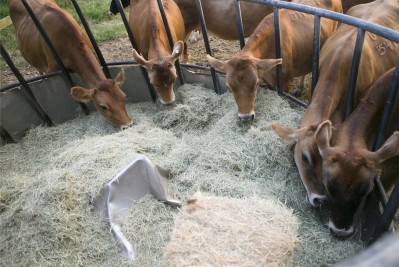Benefits of essential oils outlined but review shows lack of understanding of their mode of action

In general though, they said, EOs have been shown to enhance the production of digestive secretions and nutrient absorption, reduce pathogenic stress in the gut, exert antioxidant properties and reinforce immunity, which help to explain the enhanced performance observed in swine and poultry.
The authors, writing in the Journal of Animal Science and Biotechnology, also noted how essential oils are not simple compounds but rather a mixture of concentrated hydrophobic liquids containing volatile aromatic compounds obtained from plants.
In terms of biological activity and effects, they said each individual chemical constituent has its own characteristic properties: “This means that EOs are of a complex character with rather diverse effects. Furthermore, factors such as species, ecological factors and climatic conditions, harvest time, part of plant used and method of isolation all affect the chemical composition of EOs.”
And this variability complicates the assessment and application of the oils, added the authors.
Weight gain and FCR
Numerous studies have documented the benefits of EOs on the performance of swine and poultry, reported the Chinese team.
Franz et al, who reviewed eight reports with piglets and Windisch et al, who reviewed 11 reports with poultry, reported that the average improvement in weight gain, feed intake and feed conversion induced by EOs were 2, 0.9 and 3% for piglets and 0.5, −1.6 and −2.6% for poultry, respectively.
“We collected data missed in the two reviews, as well as recently published data. For piglets, the improvement in performance was on average 10 and 3% while in poultry the improvement in performance was 3 and 3% for weight gain and feed conversion, respectively.
The different results for the two species are possibly caused by the different digestive physiology, the origin of the EOs or herb species, the quantity added to the feed and the environmental conditions used in the trial,” said the reviewers.
Benefits for sows
The application of EOs and aromatic plants in grower-finisher pigs would appear to be unsuccessful, said the team.
Janz et al and Yan et al failed to observe any improvement in performance generated by EOs in finisher pigs.
However, the Chinese authors noted supplementation of EOs in sow diets, especially during, has been attracting increasing interest.
They reported that Miller et al found supplementation with 2g per kg of a blend of EOs from 10 days prior to the estimated farrowing date through to weaning, improved the early lactation feed intake of sows, decreased sow weight loss during the first week of lactation and enhanced piglet body weight at weaning.
And in a study involving 2,100 sows, Allan and Bilkei reported that sows fed diets containing 1g per kg of oregano had higher voluntary feed intake, lower annual mortality rate, reduced sow culling rate during lactation, increased farrowing rate, increased number of live born piglets per litter and decreased stillbirth rate.
Appetite promotion
Aromatic herbs and EOs are often claimed to improve the flavor and palatability of feed, thus increasing voluntary feed intake resulting in improved weight gain. However, the reviewers came across a trial conducted in growing pigs by Schöne et al, where the classification of fennel and caraway oils as flavor additives or as appetite promoters in diets for pigs was questioned.
But the Chinese team found shortcomings in that study: “Unfortunately, only 12 castrated male pigs were used with three treatments and only a four day trial duration, which is weak due to the low level of replication and short feeding period used. Pigs may need a few days to adapt to the special flavor of EOs. Further studies are expected in this field to justify the assumption that herbs, spices and their extracts improve feed intake in pigs.”
Digestion aids
EOs have been documented to improve nutrient digestibility in swine and poultry, said the authors.
However, Muhl and Liebert did not observe improved nutrient digestibility and enhanced pancreatic and duodenal activity of trypsin and amylase in weaned piglets fed diets containing a phytogenic product having carvacrol, thymol and tannins as key constituents.
But, in a randomized complete block design, Zeng et al investigated the acceptance of commercial EOs in low energy density weaned pig diets with wheat and extruded full fat soybean as the major ingredients.
The piglets could freely choose between a standard energy density diet or a low energy density diet with EOs.
Zeng et al found EO supplementation significantly increased weight gain and improved the apparent digestibility of dry matter, crude protein and energy compared with pigs fed the low energy density control diet.
Stability concerns
They said another important consideration is the stability of EOs during feed processing.
Maenner et al reported a considerable loss of activity of EOs when a pelleting temperature of 58 degrees Celsius was applied. These figures are smaller compared with conventional in-feed antibiotics, where advantages of 16.9% in weight gain in piglet are reported in the literature, said the Chinese academics.
However, they cited a recent feeding trial by Li et al that compared the performance of piglets fed an unsupplemented control diet with that of piglets fed a diet supplemented with antibiotics or a combination of thymol and cinnamaldehye.
Weight gain, feed conversion and fecal consistency of pigs fed EOs was essentially equal to that of pigs fed antibiotics.
Pathogen inhibition
EOs and aromatic plants are well known to exert antibacterial, antifungal and antiviral activity in in vitro experiments and it is generally accepted, they said, that EOs are slightly more active against gram-positive than gram-negative bacteria.
Comparable in vivo studies also found inhibiting effects against pathogens such as C. perfringens, E. coli or Eimeria species, said the team.
But they cautioned that more attention should also be paid to the potential negative effects induced by EOs on healthy intestinal bacteria, with Horošová et al reporting that oregano EO exhibited a strong bactericidal effect against Lactobacilli isolated from fecal samples of chickens fed diets with oregano.
Meanwhile, Cross et al and Muhl and Liebert reported that EOs had no effect on the microbial population and composition in the digestive tract or fecal excretions of broilers and pigs.
The results of other studies would indicate that, overall, there is still much work to do in order to develop a blend of EOs with better antimicrobial properties, said the Chinese reviewers.
Immune status
Supplementing EOs has been reported to improve the immune status of piglets after weaning, as indicated by an increase in lymphocyte proliferation rate, phagocytosis rate, as well as in IgG, IgA, IgM, C3 and C4 serum levels.
Walter et al reported that pigs fed a diet with 3g per kg oregano had higher proportions of CD4:CD8, MHC class II antigens and non-T/non-B cells in peripheral blood lymphocytes compared with pigs fed a control diet.
They said the bioactive substances of EOs are quickly absorbed most are metabolized and either eliminated by the kidneys. The absorbed component might initiate an immune response indicated by changes in blood immunological parameters while the unabsorbed component may contribute to relief from intestinal immune defense stress.
However, the precise mechanisms through which EOs function are not clear and further investigations are necessary, said the Chinese team.
There is limited information concerning the interaction between EOs and nutritional factors such as nutrient level, type of basal diet, as well as synergistic or antagonistic effects with other feed additives.
Jamroz et al investigated the influence of diet type – corn, wheat or barley - on the ability of plant extracts to modify morphological and histochemical characteristics of the stomach and jenunal walls in chickens.
Their results showed significantly more jenunal wall villi in chickens fed the maize diet supplemented with plant extracts.
The incorporation of carvacrol, cinnamaldehyde, and capsicum oleoresin promotes positive and negative changes in digestive function, intestinal epithelium, microbial ecology, and fermentation in weaned pigs depending on the amount of protein included in the diet.
Synergistic influence
In addition, the Chinese team cited the work of Brenes and Roura, who argued that minor components present are critical to the activity of EOs and may have a synergistic influence.
For example, carvacrol and thymol, the two structurally similar major components of oregano essential oil, were found to give an additive effect when tested against S. aureus and P. aeruginosa.
“Cymene, a biological precursor of carvacrol, was found to have a higher preference for liposomal membranes, thereby causing more expansion.
By this mechanism cymene probably enables carvacrol to be more easily transported into the cell so that a synergistic effect is achieved when the two are used together …. In the future, the detailed constituents of EOs are needed to be determined in order to assess their different biological effects,” they added.
In this way, it may be possible to compare different EO products and formulate mixtures that optimize their efficacy, concluded the meta-analysis.
Source: Journal of Animal Science and Biotechnology
Published online ahead of print doi: 10.1186/s40104-015-0004-5
Title: Essential oil and aromatic plants as feed additives in non-ruminant nutrition: a review
Authors: Zeng Z1, Zhang S1, Wang H1, Piao X1








